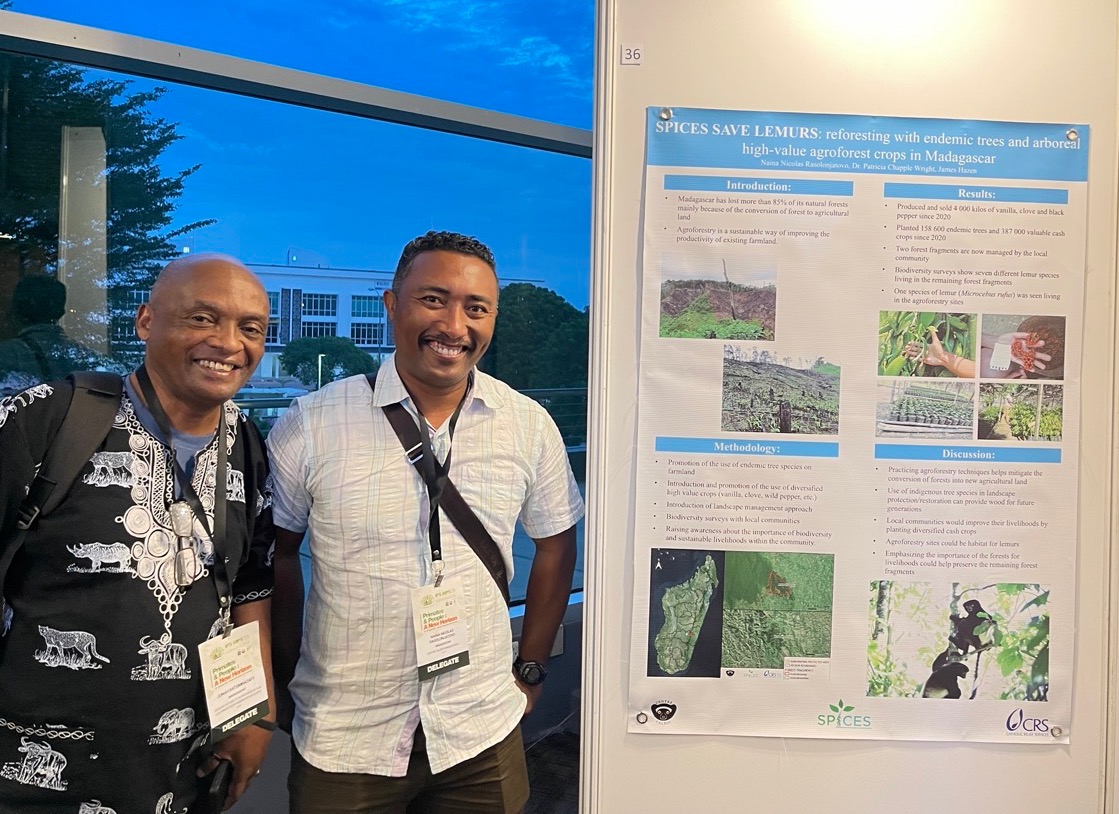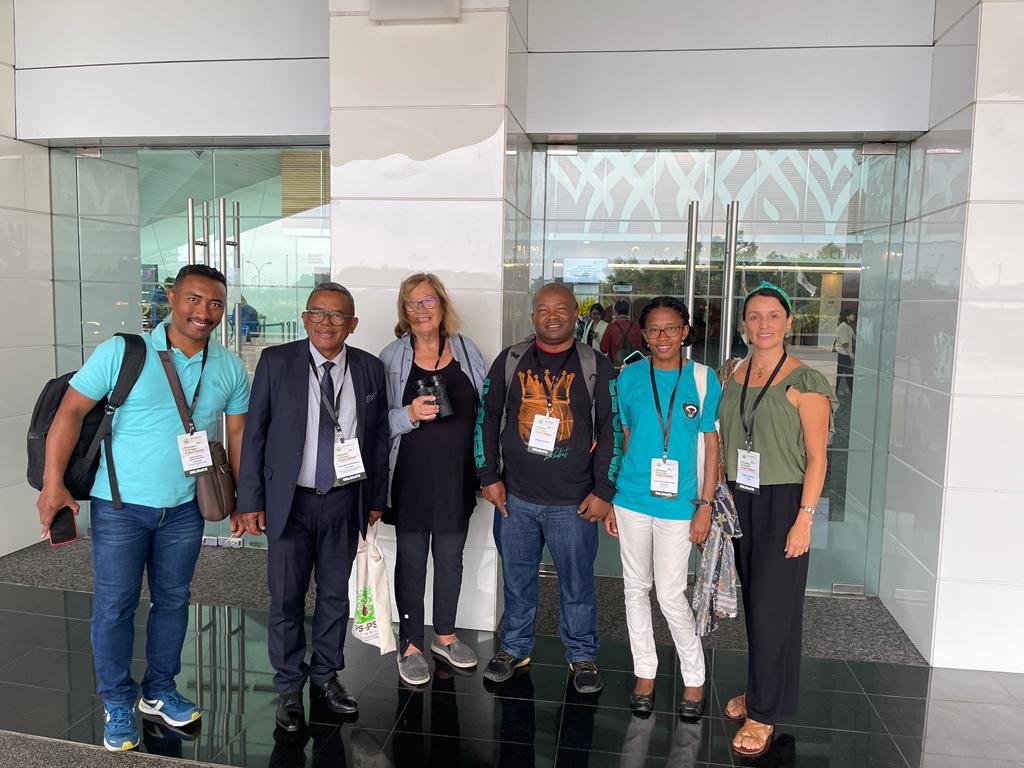CVB & MICET Attend 2023 IPS Conference in Kuching, Malaysia
We were incredibly proud to have CVB Department Heads Dr. Hasina Malalaharivony, Lovasoa Razafindravony, Nicolas Rasolonjatovo, and Dina Andrianoely present their ongoing research at this year's International Primatological Society conference. From August 19th-25th, researchers, students, and leading primatology experts from around the world gathered in Kuching, Sarawak, Malaysia to discuss this year's theme of "Primates and People: A New Horizon." The opening ceremony was led by IPS President and renowned Malagasy primatologist Dr. Jonah Ratsimbazafy. Read more about the projects presented by CVB below.
Importance of nature connectedness for environmental education around Ranomafana National Park in Madagascar
Lovasoa Razafindravony – Head of Education
Despite the fact that 98% of lemur species are endangered, many Malagasy have never seen one. Furthermore, environmental education is not a part of the school curriculum, putting conservation at risk. The education team of Centre ValBio, an eastern Madagascar research station, started to organize park visits for primary school students in 2017. In 2022, we distributed questionnaires to 63 students from primary and 142 students from middle and high school in Ranomafana. The proportion of students who have never been to the Ranomafana National Park decreased significantly (chi-square test, alpha=0,05) from primary school (73%) to middle and high school (27%). However, the proportion of the students who have never seen a lemur did not decrease significantly from primary school (32%) to middle and high school (26%), which suggest only limited increase in experience as the students get older. Secondary and high school students filled the questionnaire before and after the park visit, and they answered a set of questions about their willingness to support conservation. The only significant difference found after the park visit was a higher willingness of students to properly manage their garbage. There was no significant change in their willingness to plant trees, spread awareness about conservation, avoid slash and burn agriculture, or study conservation at a college. This result suggests that the students need to be exposed to conservation education repeatedly and for a prolonged period of time in order to change their attitudes.
SPICES SAVE LEMURS: reforesting with endemic trees and arboreal high-value agroforest crops in Madagascar
Nicolas Rasolonjatovo – Head of Restoration Ecology
 Reforestation after slash-and-burn agriculture improves the health of humans and wildlife
by filtering and sequestering clean water, preventing landslides, and providing cooler
air temperatures. By planting lemur food trees, reforestation has the added benefit
of providing endangered species with fruits and flowers, aiding survival into the
future. In the region around Ranomafana National Park, Madagascar we have demonstrated
a third benefit. Planting high-value arboreal crops on endemic trees provide a profitable
income stream for farmers. Throughout the past five years, the Centre ValBio Research
station team has joined with Catholic Relief Services and communities in more than
65 villages to plant half a million trees a year. High-value arboreal plants such
as Vanilla planifolia and wild pepper (Voatsiperifery) an endemic pepper recently discovered in and around the Ranomafana forest are planted
onto the trees and within three years produce yields. These crops sell for ten times
the recent price of rice. Our CVB and CRS team has provided training in organizing
community cooperatives, selecting the tree species to grow in the nursery, caring
for and planting saplings, pollination of vanilla, and nourishing the peppercorn vines.
A pilot study has shown that endemic species of wildlife including chameleons, tenrecs,
bats, and birds return to the reforestation plots within five years and nocturnal
lemurs such as mouse lemurs can return within a decade. CVB and its partners reforest
with endemic trees to provide future food for lemurs and other native species while
increasing the livelihoods of rural Malagasy communities.
Reforestation after slash-and-burn agriculture improves the health of humans and wildlife
by filtering and sequestering clean water, preventing landslides, and providing cooler
air temperatures. By planting lemur food trees, reforestation has the added benefit
of providing endangered species with fruits and flowers, aiding survival into the
future. In the region around Ranomafana National Park, Madagascar we have demonstrated
a third benefit. Planting high-value arboreal crops on endemic trees provide a profitable
income stream for farmers. Throughout the past five years, the Centre ValBio Research
station team has joined with Catholic Relief Services and communities in more than
65 villages to plant half a million trees a year. High-value arboreal plants such
as Vanilla planifolia and wild pepper (Voatsiperifery) an endemic pepper recently discovered in and around the Ranomafana forest are planted
onto the trees and within three years produce yields. These crops sell for ten times
the recent price of rice. Our CVB and CRS team has provided training in organizing
community cooperatives, selecting the tree species to grow in the nursery, caring
for and planting saplings, pollination of vanilla, and nourishing the peppercorn vines.
A pilot study has shown that endemic species of wildlife including chameleons, tenrecs,
bats, and birds return to the reforestation plots within five years and nocturnal
lemurs such as mouse lemurs can return within a decade. CVB and its partners reforest
with endemic trees to provide future food for lemurs and other native species while
increasing the livelihoods of rural Malagasy communities.
Comparison of the activity budgets of two populations of greater bamboo lemurs (Prolemur simus) from degraded forest and protected area in Madagascar
Dr. Hasina Malalaharivony – Head of Research
Habitat degradation and food availability have strong effects on animals’ lives, health, and survival. In this project, we assessed the differences in the activity budgets of two populations of greater bamboo lemurs (Prolemur simus) from two different areas: the Ivato Karianga degraded forest and the Talatakely Ranomafana National Park, a protected forest. The greater bamboo lemur is a Critically Endangered primate species endemic to Madagascar. Their habitats are mostly threatened by human activities such as agriculture and wood collection. Here we collected behavioural data from the two populations from both sites (N=31) during four years (2008, 2009, 2010 and 2019) using the scan sampling method with a total of 1500h of observations. The activity budgets of the two populations are different. The proportion of time spent traveling and resting are significantly different (Wilcoxon test, alpha= 0.05). The Ivato population spent more time traveling and less time resting compared to the Talatakely population. Habitat degradation decreases food availability, which increases travel time for food research. Resting time is reduced in degraded areas, probably to reduce mortality risk from predation, human pressures, and starvation. More traveling and less resting time could also be related to stress in the presence of observers. Feeding times did not differ between the two populations (Wilcoxon test, alpha=0.05). These results indicate the influence of habitat degradation on species activities and lifestyle.
The Translocation of Prolemur simus to Ranomafana National Park.
Dina Herilala Andrianoely – Head of Biodiversity
Prolemur simus, the greater bamboo lemur, is a critically endangered primate endemic to Madagascar. Most of their remaining habitats are threatened by human activities such as rice agriculture. This project aimed to transfer 12 individuals from the Ivato Karianga fragmented forest to Ranomafana National Park (RNP), a protected area since 1991. In 2008, when we started monitoring of the Ivato Karianga population, there were only 43 individuals. However, the population was growing fast and increased to 108 individuals in 2017. The local people extended the land use for agriculture, causing the loss of the 41% of the bamboo forest and thus reducing the extent of the lemur habitat from 71 ha to 29.4 ha. We did not observe any instances of crop raiding between 2008 to 2015, but during March–April 2017 the lemurs started eating crops, such as rice, cassava or banana. Farmers complain about crop raiding and their attitude towards lemurs is changing. We never observed lemur traps between 2008 and 2017, but we found 5 traditional traps in 2017 and 2019. To support the small greater bamboo lemur population in RNP and avoid killing by frustrated farmers in Ivato Karianga, a translocation program was carried out by CVB, Madagascar National Parks, and Parc Tsimbazaza. Long term monitoring is needed to assess the adaptation of the individuals to their new habitats and examine their reproductive success.

From left to right: Nicolas, MICET Country Director Benjamin Andriamihaja, Dr. Patricia Wright, Dina, Lovasoa, and Dr. Moníca Ramírez at IPS
